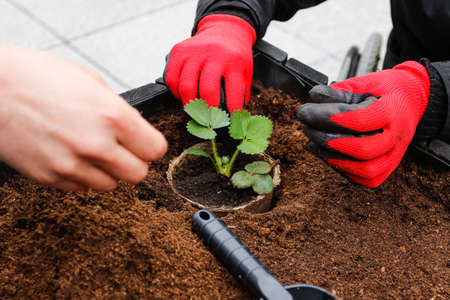1. Getting Started with Your Allotment
Allotments are a cherished part of British gardening culture, offering both seasoned horticulturists and enthusiastic beginners the opportunity to cultivate their own produce within a supportive community setting. Before you begin sowing seeds, it is essential to familiarise yourself with your specific site’s rules and guidelines. Each allotment association may have its own regulations regarding plot maintenance, composting, permitted structures, and communal responsibilities—so be sure to read through any documentation provided by your site manager or committee.
The rhythm of an allotment year in the UK is governed by the seasons. Preparation for successful seed sowing begins in late winter to early spring, when most plots are cleared of debris and beds are prepared for planting. This period is ideal for assessing soil quality, improving fertility with organic matter, and planning your crop rotation to maximise productivity while minimising pest problems. Essential tools include a sturdy spade, fork, rake, watering can or hose, and basic hand tools such as trowels and dibbers. Consider investing in a compost bin or heap if one isn’t already available on your plot; this will help you recycle plant waste into valuable soil improver.
Setting up your plot for seed sowing also means understanding local microclimates and drainage patterns. Take note of areas that receive more sunlight or are prone to waterlogging after rain. Mark out clear beds and paths using string or boards to make future maintenance easier. By taking these initial steps, you’ll lay a strong foundation for a successful growing season—and quickly become an integral part of the vibrant UK allotment tradition.
2. Selecting and Sourcing Seeds
Choosing the right seeds is a crucial first step for any new UK allotment holder. The variable British climate means that some crops thrive more readily than others, so careful consideration will help ensure a productive growing season. This section guides you through understanding seed packets, selecting varieties suited to local conditions, and sourcing seeds from reputable suppliers or community swaps.
Understanding the UK Climate and Suitable Seed Choices
The UKs temperate maritime climate is characterised by cool summers, mild winters, and regular rainfall. When selecting seeds, opt for varieties known to perform well in these conditions. Below is a quick reference table highlighting popular crops for UK allotments and their suitability:
| Crop | Sowing Time | Climate Suitability | Notes |
|---|---|---|---|
| Carrots | Mar–Jun | Excellent | Choose early and maincrop types for staggered harvests. |
| Cabbages | Feb–May (indoors) | Very Good | Select hardy varieties for winter harvesting. |
| Runner Beans | Apr–Jun | Good | Require support; prefer sheltered spots. |
| Lettuce | Feb–Sep | Excellent | Tolerates cooler temperatures; multiple sowings possible. |
| Courgettes | Apr–Jun (indoors/outdoors) | Moderate | Plant out after last frost for best results. |
How to Read and Interpret Seed Packets
Seed packets in the UK are packed with vital information. Familiarise yourself with the following key details commonly found on British seed packets:
- Sowing Period: Indicates the months when seeds should be sown either indoors or outdoors.
- Harvest Time: Guides you on when you can expect to start picking your crops.
- Germination Temperature: Ensures you sow at suitable temperatures for successful sprouting.
- Variety Details: Describes disease resistance, flavour notes, and growth habits.
- Packing Date & Use By: Check freshness to ensure high germination rates.
- Sowing Depth & Spacing: Helps prevent overcrowding and supports healthy growth.
Sourcing Seeds: Where Quality Counts
Reputable British Suppliers
Selecting seeds from trusted sources increases your chances of success. Well-known UK suppliers such as RHS Plants, Thompson & Morgan, Suttons Seeds, and Kings Seeds offer robust varieties bred specifically for British gardens. These suppliers also provide expert advice on cultivation tailored to UK conditions.
The Value of Community Seed Swaps
An increasingly popular option among allotmenteers is participating in local seed swaps or gardening clubs. Not only do these events offer access to heritage or locally-adapted varieties, but they also foster a sense of community and shared learning. Check noticeboards at your allotment site or visit organisations like Seedy Sunday or the Heritage Seed Library for upcoming events.
Quick Checklist: Sourcing Quality Seeds in the UK
- Check supplier reputation – read reviews or ask fellow allotmenteers.
- Select varieties with proven performance in UK conditions.
- Aim for fresh seed stock with clear use-by dates.
- Diversify sources by exploring both commercial outlets and community exchanges.
Selecting and sourcing the right seeds ensures a strong foundation for your allotment journey, helping you grow crops that flourish under the unique conditions of the British climate.

3. Soil Preparation and Plot Planning
Assessing Your Allotment’s Soil Health
Before sowing your first seeds, it’s essential to understand the current state of your allotment soil. Start by visually inspecting for signs of compaction, stony areas, or persistent weeds. Take a handful of soil and squeeze—it should crumble easily rather than form a hard ball. For a thorough assessment, consider a simple pH test kit from your local garden centre; most UK vegetables prefer a slightly acidic to neutral pH (6-7). Good soil should also have a fresh, earthy smell and be rich in organic matter, indicating healthy microbial activity.
Enriching Your Plot Organically
Building fertile soil is the cornerstone of successful allotment gardening. Incorporate well-rotted manure or homemade compost annually in autumn or early spring to improve structure and nutrient levels. Green manures, such as field beans or clover, can be sown over winter to fix nitrogen and suppress weeds. Avoid using peat-based products, in line with UK sustainability efforts. Regular mulching with organic materials helps retain moisture and further enriches the soil as it breaks down.
Effective Crop Rotation Systems for UK Plots
Planning crop rotation is vital for disease prevention and soil health on UK allotments. A traditional three- or four-year rotation system works well: group crops into families—brassicas (cabbages, broccoli), legumes (peas, beans), roots (carrots, parsnips), and others (potatoes, onions). Each year, shift plantings so that each group occupies a different section of your plot. This minimises pest build-up and nutrient depletion specific to crop families. Draw up a simple plan or map for your allotment at the start of each season to keep records clear and ensure consistent rotation.
Top Tips for Plot Planning Success
- Mark out beds with clear paths to avoid compacting growing areas.
- Keep taller crops like sweetcorn towards the north edge to prevent shading others.
- Allow space for compost bins or water butts—a must-have for efficient UK gardening.
Summary
By assessing your soil health, enriching organically, and planning crop rotations tailored to UK conditions, you’ll set strong foundations for productive growth from seed on your new allotment.
4. Sowing and Caring for Your Crops
Step-by-Step Support for Sowing Seeds Indoors and Outdoors
Establishing strong, healthy plants starts with the right sowing technique, tailored to the unpredictable UK climate. Begin by checking your seed packets for recommended sowing times, as British weather varies considerably between regions.
Sowing Seeds Indoors
- Fill clean seed trays or pots with a quality seed compost.
- Sow seeds thinly across the surface and lightly cover with a fine layer of compost or vermiculite as advised on the packet.
- Water gently using a fine rose watering can to avoid displacing seeds.
- Cover trays with a clear lid or polythene bag to retain moisture until germination.
- Place in a bright, frost-free spot such as a windowsill or unheated greenhouse.
Sowing Seeds Outdoors
- Prepare soil by removing weeds and breaking up clumps; rake to a fine tilth.
- Sow seeds at the depth and spacing specified on the packet—often best done in drills (shallow grooves) marked with string lines for accuracy.
- Gently firm soil over seeds and water well if conditions are dry.
- Protect early sowings from late frosts using fleece or cloches as needed.
Watering: Striking the Right Balance
| Weather Condition | Watering Frequency |
|---|---|
| Damp/Cool (typical UK spring) | Once every 5-7 days; check soil before watering |
| Warm/Dry spells | Every 2-3 days; water deeply in mornings or evenings |
Avoid overhead watering to reduce risk of fungal disease—use a watering can at soil level where possible.
Weeding and Thinning: Essential Maintenance
Weeding
- Remove weeds regularly by hand or with a hoe, especially when young and before they set seed.
- Persistent perennial weeds should be dug out entirely to prevent regrowth.
Thinning Seedlings
- Thin seedlings as soon as they are large enough to handle, leaving the strongest plants spaced according to packet instructions.
- This prevents overcrowding, improves air circulation, and reduces vulnerability to pests common in damp British summers like slugs and snails.
Pest Watch: Typical UK Challenges
- Slugs & Snails: Use barriers (e.g., copper tape), hand-pick in evenings, or apply wildlife-friendly pellets.
- Pigeons & Birds: Protect young crops with netting or horticultural fleece.
Caring for your crops means regular attention adapted to the quirks of British weather—be ready to adjust routines through the season, keeping a close eye on local conditions and your allotment’s unique microclimate. With patience and persistence, you’ll nurture healthy plants from seed to harvest.
5. Managing Challenges on the Allotment
Adapting to Unpredictable UK Weather
The British climate is renowned for its unpredictability, posing unique challenges for new allotment holders. Sudden downpours, unexpected frosts, and dry spells can all impact seedling establishment and crop yields. To mitigate these risks, consider investing in fleece or cloches to protect young plants from cold snaps. Raised beds can improve drainage during heavy rainfall, while mulching helps retain moisture during dry periods. Regularly check local forecasts and be prepared to cover or water your crops as conditions demand.
Tackling Local Pests: Traditional Foes of the Allotment
Pests such as slugs, snails, pigeons, and aphids are common adversaries on UK allotments. Physical barriers like netting and copper tape offer effective, chemical-free protection against many of these nuisances. Beer traps and hand-picking remain tried-and-tested methods for managing slug populations. Encourage natural predators such as birds and hedgehogs by creating wildlife-friendly spaces around your plot. For persistent problems, companion planting—such as marigolds to deter aphids—can provide a sustainable solution.
Sustainable Pest and Disease Management
Opt for integrated pest management (IPM) strategies to maintain a healthy balance on your allotment. Rotate crops annually to prevent disease build-up in the soil. Choose disease-resistant varieties whenever possible and remove any infected plants promptly to reduce spread. Keep tools clean and avoid working on wet soil to limit fungal diseases. Home-made remedies, such as garlic spray for aphids or soapy water for mildew, are both eco-friendly and effective.
Allotment Guidelines and Community Support
Every site will have its own rules regarding pesticide use, composting, and waste disposal. Familiarise yourself with these guidelines to ensure you comply with local best practices. Don’t hesitate to seek advice from neighbouring plot holders; their experience can be invaluable when facing unfamiliar challenges.
Summary: Building Resilience
Managing an allotment in the UK requires patience, observation, and adaptability. By embracing sustainable techniques and learning from fellow gardeners, you’ll develop practical solutions for common issues—ensuring both your crops and your confidence continue to grow season after season.
6. Harvesting and Enjoying Your Produce
Recognising When to Harvest
Knowing exactly when to harvest is key for both flavour and yield. Each crop has its tell-tale signs: tomatoes should be fully coloured and slightly soft to the touch, while potatoes are best lifted once their foliage yellows and dies back. Root vegetables like carrots and parsnips can be gently pulled after they reach a desirable size, but avoid leaving them too long as they may become woody. Regularly check your crops, as UK weather can quickly change ripening times.
Gathering Your Crops: Best Practices
Harvest on dry days if possible to prevent spreading soil-borne diseases. Use sharp, clean secateurs or knives for cutting produce such as courgettes and beans, and gently twist or pull root veg to avoid damage. For leafy crops like lettuce and spinach, cut outer leaves first to allow for continued growth. Always handle your produce carefully to minimise bruising, which can shorten storage life.
Storing Your Allotment Bounty
Proper storage ensures you enjoy your home-grown produce well beyond the summer months. Root vegetables such as potatoes, carrots, and beetroot keep best in cool, dark, well-ventilated conditions – traditional hessian sacks or wooden crates in a shed work well in the UK climate. Onions and garlic should be thoroughly dried before being strung up or stored in mesh bags. Soft fruits are best enjoyed fresh or preserved as jams or chutneys.
Sharing Your Harvest
The spirit of allotment gardening thrives on community. Surplus crops can be shared with neighbours, friends, or local food banks – a tradition cherished across many British allotment sites. Swapping gluts of courgettes for someone else’s runner beans keeps variety on the plate and builds friendships within your site’s community.
Enjoying Your Home-Grown Flavours
There’s nothing quite like the taste of freshly picked produce from your own plot. From classic British staples such as roast potatoes and rhubarb crumble to salads bursting with home-grown greens, your efforts will be rewarded at every meal. Take pride in the sustainable journey from seed to table, knowing each bite reflects your skill and care as an allotment holder.


